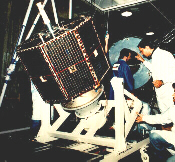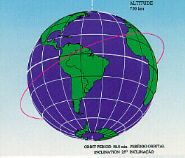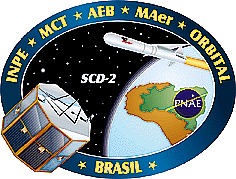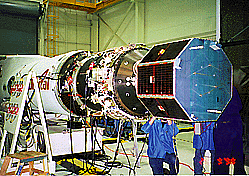| The information of this web-page were | |
| extracted of the site : | http://www.inpe.br/programas/mecb/default.htm |
| MECB | |
The Brazilian Complete Space Mission (MECB) comprises the development and operation in orbit of small satellites with applications in environmental data collection and remote sensing, directed to specific Brazilian needs. SCD1 (First Data Collection Satellite) was the first satellite designed, manufactured, integrated and tested in Brazil. SCD1 was launched using the OSC Pegasus in February, 9th, 1993 and is still operating in orbit, despite the specified life time of one year. |
SCD-1 Satellite Integration |
| SCD1 | |
The SCD1 satellite is a data collection satellite with the following characteristics of shape (octagonal base prism), dimension (1m diameter and 1 m height), mass (110 Kg), power (110W), structure (aluminum), honeycomb solar panels, stabilization (spin), thermal control (passive), data collection transponder on UHF/S bands, TT&C on S-band and orbit (circular, 750Km height, 25 degrees of inclination). For development purposes, one solar cell experiment flies with the satellite. This experiment was totally produced in Brazil, aiming to achieve technology and manufacturing capability of silicon solar cells. More information about this experiment of the SCD1 satellite is in this web-page: http://www.las.inpe.br/~veissid/eng19.html |
SCD-1 orbit |
| SCD2 | |
SCD2 is very similar to SCD1 and has the following characteristics of shape (octagonal base prism), dimension (1m diameter and 1 m height), mMass (117 kg), power (110W), structure (aluminum honeycomb solar panels), stabilization (spin constant of 34 rpm), tThermal Control (passive), data collection transponder on UHF/S bands, TT&C on S-band, reaction wheel experiment and orbit circular (750km height, 25 degrees of inclination). For radiation damage study purposes, other solar cell experiment flies with this satellite. This experiment was also totally produced in Brazil. More information about this experiment is in this web-page: http://www.las.inpe.br/~veissid/eng20.html |
SCD-2 logo |
| Launched again with one Pegasus rocket on October, 22nd, 1998, SCD2 is since the beginning of the orbital life performing the data collection mission, giving continuity and improving SCD1 services. Even though the nominal life specified for the mission is two years, it is expected that this period will be widely exceeded, in consonance with what is happening with SCD1. |
SCD-2 Integration with Pegasus |



